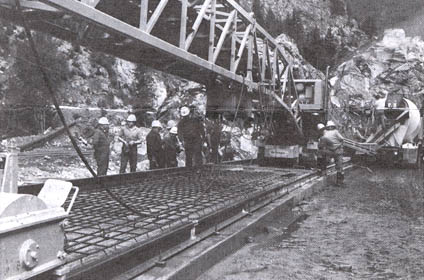
Volume 14
Number 16
Dec. 5, 1984
|
 |
Novel Track Structure Receives First N.A. Test on
CP Rail Main Line in Albert Canyon, B.C.
By Steve Morris

Only in Canada: A new 283.5-meter
long (930-foot) track structure, the first of its kind in North America, is undergoing tests
on CP Rail's main lin in the Selkirk Mountains. CP Rail is testing the Pact-Track system for
the next two years to determine if it can withstand wear and tear before placing it in two tunnels being
constructed as part of the Roger Pass double tracking project.
Revelstoke, B.C. - A new 283.5-meter-long
(930-foot) track structure, the first of its kind in North America, has been installed and is
being tested by CP Rail in British Columbia.
Pact-Track is a new type of railway roadbed that increases safety, reduces on-going
maintenance costs and greatly improves rolling stock ride.
Developed by British Rail, Pact-Track uses a reinforced cast-in-place concrete
foundation and rail clips to hold rails in position, replacing the use of crushed rock or slag ballast and
wood or concrete railway ties.
The test section is located in Albert Canyon, 24 kilometers (15 miles) east of here.
CP Rail is testing the track under some of the most severe weather conditions in Western Canada to determine
how well it can withstand the elements, before installing it in the Mount Macdonald and Mount Shaughnessy
tunnels.
"When we were in the design stages of the Rogers Pass Project we were looking for a type of roadbed to
put in the two tunnels which would withstand the forces of heavy-tonnage trains and yet would
require the least amount of on-going maintenance", said John Fox,
vice-president engineering, special projects.
"What impressed us with Pact-Track was it was designed specially for tunnels, and once
installed required very little maintenance.
Although the cost per mile of Pact-Track installed is higher than conventional tie and ballast
trackage, the long term savings justify its initial greater costs.
"We expect to triple our capacity on the 34 Km (21 miles) of new track we are building up the Beaver
Valley and under Rogers Pass", said Mr. Fox.
"With a conventional track structure we could expect to have regular track closures in the new tunnels
for tie replacement and upgrading ballast. Pact-Track withstands wear thereby reducing these
track closures to an absolute minimum, allowing us to continue moving goods without delays".
Overseeing the installation was Transmark, the consulting arm of British Rail.
In September, a reinforced concrete foundation was poured, and once it was cured, the surface was roughened
to improve the bonding of the second layer of concrete.
This second layer was installed with the Pact-Track machine, which had been shipped to Canada
from England and assembled at the site.
The machine, installed on rails secured to the outside of the concrete base on which the
Pact-Track is laid, was capable of travelling at a speed of about 3.2 Kmh (2 mph).
Concrete was fed into the front end of the machine and travelled along a 10.6-meter-long
(35-foot) conveyor belt towards the rear of the machine.
Prior to the installation of the final layer of concrete, a team of about eight men clipped and welded in
place steel mesh reinforcement.
After the final layer had cured, 136-pound-per-yard continuous welded rail was placed on a thin
rubber compound pad and clipped to the Pact-Track base.
"This pad is the vital element in the system", said Mr. Fox. "It cushions the force of a
train passing over it, thereby preventing damage to the concrete".
Plastic insulators were inserted between the rails and the rail-holding clips. These prevent
short circuits and interference with the Centralized Traffic Control system which governs the movement of
trains through the area.
TREND SETTERS
"When looking for a location to test the system, we wanted an area which would have the same climatic
conditions and track curvatures", said Mr. Fox. "The Albert Canyon location met these criteria and
the results are classified as field tests under actual conditions.
"No other railway in North America has tried this system so we are breaking new ground
here".
This CP Rail News article is copyright 1984 by
Canadian Pacific Railway and is reprinted here with their permission. All
photographs, logos, and trademarks are the property of the Canadian
Pacific Railway Company.
|
|